Ankle Sprain
An ankle sprain refers to the tearing of the ligaments of the ankle. Ankle sprain is a common injury with a high rate of recurrence usually as a result of landing on a plantar flexed and inverted foot. Ankle sprains account for 85% of ankle injuries and 85% of sprains are of the ligaments on the outside of the foot. They account for 25% of all sports-related injuries. Risk can be increased in individuals that are overweight and less physically active. Weekend type athletes also have an increased risk. The lateral ligaments are most commonly involved, then the medial ligaments. Ankle sprains are usually treated non-surgically.
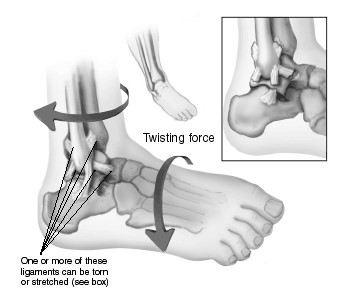 |
Signs and Symptoms
- Patients report of pain after having twisted their ankle. It commonly occurs during sports.
- Patients will complain of pain on the outside of their ankle and various degrees of swelling and bleeding under the skin (i.e. bruising).
- Depending on the severity of the sprain, a person may or may not be able to put weight on the foot.
Diagnosis
- Pain on the outside of the ankle
- Swelling and tenderness over the injury
- An X-Ray to rule out a fracture.
How can physiotherapy help?
Treating your sprained ankle properly may prevent chronic pain and instability. All ankle sprains, from mild to severe, require three phases of recovery :
- Phase I : includes resting, protecting and reduce the swelling of your injured ankle.
- Phase II : includes restoring your ankle’s flexibility, range of motion and strength.
- Phase III : includes gradually returning to straight-ahead activity and doing maintenance exercises.
For Acute Phase, goals are aimed at decreasing swelling and pain, protecting from further injury and allowing protected gait as tolerated.
Follow the P.R.I.C.E. guidelines :
- Protect – avoid from doing strenuous activities involving the ankle.
- Rest your ankle by not walking on it. Limit weight bearing.
- Ice it to keep down the swelling. Don’t put ice directly on the skin and don’t dab the ice more than 20 minutes at a time to avoid ice burn.
- Compression can help control swelling as well as an immobilize and support your injury.
- Elevate the foot by reclining and propping it up higher than the waist or heart.
Pain Relief
Heat and cold therapy is applied to enhance relaxation and reduce pain. It is important to use ice after exercise and after any activity that causes discomfort. Pulsed electrical stimulation can also be used to relieve the pain. Electric stimulation will help to improve the blood circulation, thus enhancing the healing process and reducing any swelling or discomfort.
Exercise
Stretching and strengthening exercises need to be done regularly. Exercises will restore the movement and maintain the adequate strength and stability of the ankle joint.
Early mobilization can lead to earlier return to work and patient comfort. You should perform the following stretches in stages once the initial pain and swelling have receded, usually within five to seven days. Firstly is the restoration of ankle range of motion, which should begin when you can tolerate weight bearing. Consider these home exercises when recuperating from an ankle sprain. Perform them twice per day.
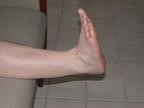 |
 |
|
While seated, bring your ankle and foot all the way up as much as you can. Do this slowly, while feeling a stretch in your calf. Hold this for a count of 10. Repeat 10 times. |
In the same position, point your toes down. Do this slowly, while feeling a stretch in front of your leg. Hold this position for a count of 10. Repeat 10 times. |
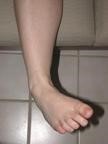 |
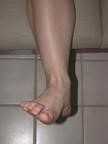 |
|
While seated bring your ankle down and in. Hold this inverted position for a count of 10. Repeat 10 times. |
In the same position, bring your ankle up and out. Hold this everted position for a count of 10. Repeat 10 times. |
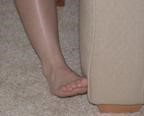 |
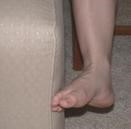 |
|
Place your ankle in the “down and in” position and push against a fixed object such as a couch. Hold this position for a count of 10. Repeat 10 times. |
Place your ankle in the “up and out” position and push against the same object. Hold this position for a count of 10. Repeat 10 times. |
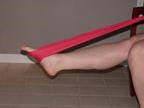 |
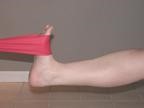 |
|
Using a resistance band around your forefoot, hold the end of the band with your hand and gently push your ankle down as far as you can and then back to the starting position. Repeat 10 times. |
Tie the resistance band around a fixed object and wrap the other end around your forefoot. Start with your foot pointing down and pull your foot up as far as you can. Return to the starting position and cycle your ankle 10 times. |
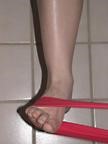 |
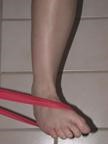 |
|
Loop the outside of your foot with the band and secure it to an object to the inside of your ankle. Pull your foot up and outwards and then back to the start position. Repeat 10 times. |
Loop the inside of your foot with the band and secure it to an object to the outer side of your ankle. Pull your foot down and inwards. Return to the start position and repeat 10 times. |
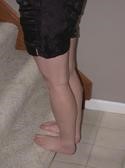 |
This stretch should be done only when the pain in your ankle has significantly subsided. While standing on the edge of a stair, drop your heels down and hold this stretched position for a count of 10. Repeat 10 times. |
Once the ankle range of motion has been almost or completely restored, you must strengthen your ankle. Along with strengthening, you should work toward a feeling of stability and comfort in your ankle (Proprioception).
Once you have regained the motion and strength in your ankle, you are ready for activities such as gentle jogging and biking.
Prevention
The best way to prevent ankle sprains is to maintain good strength, muscle balance and flexibility.
- Warming-up before doing exercises and vigorous activities
- Pay attention to walking, running and working surfaces
- Wear good shoes
- Pay attention to your body’s warning signs to slow down when you feel pain or fatigue
References
- Denegar, C., Hertel, J., Fonseca, J.(2002). The Effect of Lateral Ankle Sprain on Dorsiflexion Range of Motion, Posterior Talar Glide, and Joint Laxity. J Orthop Sports Phys Ther. 32(4):166-173.
- Docherty CL, Moore JH, Arnold BL. Effects of strength training on development and joint position sense in functionally unstable ankles. J Athl Train. 1998; 33(4):310-314.
- Garrick, J.G.(1977). The frequency of injury, mechanism of injury and epidemiology of ankle sprains. Am J Sports Med. 5(6): 241-242.
- Hintermann B.(1999). Biomechanics of the unstable ankle joint and clinical implications. Med Sci Sports Exerc. 31(7):S459-69.
- http://orthoinfo.aaos.org/ Retrieved August 3, 2015
- http://www.webmd.com/pain-management/types-of-ankle-sprains (Retrieved August 3, 2015)
Source image
- www.aofas.org/footcaremd/how-to/foot-injury/
| Last Reviewed | : | 23 August 2019 |
| Writer / Translator | : | Ismawi bin Ismail |
| Accreditor | : | Daaljit Singh a/l Harbachan Singh |
| Reviewer | : | Halimah bt. Hashim |







